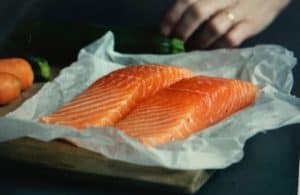Natural Anti-Inflammatories for Chronic Pain: A Safe Alternative to NSAIDS

It is never easy to be in pain, but with many of us stuck at home and limiting our time spent out in the community, it is difficult or impossible to attend regular physical therapy sessions to get the help we need to address our aches and mobility issues. Fortunately, there are some easy things that we can do, even when quarantined at home, to help alleviate pain and improve our daily function. That begins with decreasing the widespread inflammation in the body.
Chronic Inflammation
People who suffer from chronic pain also typically also experience chronic systemic inflammation– a prolonged, overly reactive immune system response. Inflammation, when experienced short term, helps to keep our bodes safe to heal injuries and protect us from dangerous pathogens or irritants. When the inflammatory process goes unchecked for long periods of time it can keep our body in a constant state of stress and high alert. Over time, chronic systemic inflammation exerts negative effects on the body’s cells and tissues, resulting in persistent or recurrent pain, malaise, and/or fatigue.
NSAID Use
It is common medical practice to recommend over-the-counter and prescription nonsteroidal anti-inflammatory drugs (NSAIDs), such as aspirin, ibuprofen, and naproxen, for acute injuries to combat pain and a strong inflammatory process. However, the long-term use of NSAID medications to treat chronic pain draws into question the safety of these drugs, which may result in potentially serious side effects to the gastrointestinal, renal, and cardiovascular systems. (1) Rather than reaching for that bottle of ibuprofen day after day to fight inflammation and pain, let’s take a look at natural anti-inflammatory items that you can add to your diet to improve your comfort, complement your work with your physical therapist, and promote an environment of healing within the body for a long-term pain management solution.
Recently, more natural alternatives to NSAIDS are being studied and some have been found to be significantly effective in reducing the inflammatory response and its associated pain. These natural anti-inflammatories are substantially safer for long-term use than NSAIDS and are effective alternatives that enhance the quality of life by allowing individuals to perform the activities they want to perform free from pain., Tart cherry juice, turmeric, fish oil, and green tea are a few natural substances that are being extensively researched and have, thus far, demonstrated safe and efficacious results in decreasing the deleterious effects and pain of chronic inflammatory conditions and diseases. (1-10)
Effective Natural Solutions to Pain and Inflammation
- Tart Cherry Juice
- Turmeric
- Fish Oil
- Green Tea
Tart Cherry Juice

Tart cherries contain biochemical compounds such as flavonoids and anthocyanins, making them a great source of antioxidants and giving them highly anti-inflammatory properties. (2) Tart cherry juice has demonstrated successful trials in reducing inflammation and pain in many populations, ranging from young healthy women, high endurance athletes, individuals with chronic pain conditions such as fibromyalgia, to elderly women with osteoarthritis. (2-5)
Consumption of two 280g servings of tart cherries (~ 45 cherries) a day has been shown to reduce circulating inflammatory markers in healthy women. (3)
According to a study by Oregon Health & Science University, consuming two 355 mL bottles of tart cherry juice, (~90 to 100 cherries) for eight consecutive days significantly reduced symptoms of exercise-induced muscle pain among runners participating in a vigorous endurance event compared to a “cherry juice placebo.” (2)
In a study of women (ages 40-70 years old) with osteoarthritis, those who consumed two 10.5 oz bottles tart cherry juice (~50-60 cherries) reported significantly reduced inflammatory pain events, and demonstrated increased preservation of muscle function and strength, as well as decreased blood serum inflammatory biomarkers than women who drank a cherry placebo drink.
Turmeric

Turmeric is a whole root or spice, much like ginger, derived from the Southeast Asian turmeric plant. It has been traditionally used for its medicinal and healing properties for thousands of years. The main biochemically active component of turmeric, curcumin, is another very well-known safe, natural anti- inflammatory agent that has been used to relieve pain by regulating the activity of enzymes and cytokines that inhibit the inflammatory pathways. (1,6)
A 2019 study demonstrated that individuals with knee osteoarthritis receiving turmeric as a treatment experienced pain relief effects and quality of life improvements similar to individuals taking diclofenac (a common NSAID) and reported significantly less adverse effects. (6)
According to the National Institute of Health, the usual dosage of turmeric is 400-600mg taken three times per day in pill or loose powder form to reduce inflammation and pain. (1)
Consuming a pinch of black pepper with turmeric is also recommended as it allows your body to better absorb and use curcumin. (7) Although considered safe, turmeric should be used cautiously as it can cause stomach upset when consumed in larger quantities.
**Always consult with a physician before taking turmeric, especially if using anticoagulant medications or high doses of nonsteroidal drugs.
Fatty Fish and Fish Oil

Fish oil is a popular supplement recommended for individuals with joint pain such as osteoarthritis, rheumatoid arthritis, and bursitis. Rich in omega-3’s, fish oil or diets that include fatty fish contain some of the most effective natural anti-inflammatory agents available. (1,8) Fatty fish contains two types of omega-3s, docosahexaenoic acid (DHA) and eicosapentaenoic acid (EPA). The body cannot produce DHA or EPA and so it is essential that we consume these fatty acids regularly in our diet.
To achieve therapeutic benefit and fight inflammation, the American Heart Association recommends 250-500 mg of DHA and EPA oil per day or consumption of two 3oz fatty fish servings per week to decrease vascular inflammation and prevent cardiovascular disease. (8) Recommended fatty fish include:
- Salmon
- Mackerel
- Herring
- Lake trout
- Sardines
- Albacore tuna
** As always, be sure to consult with your physician or licensed dietitian before beginning fish oil supplements, especially If you are taking blood-thinners as fish oil can increase their effect.
** Due to potentially dangerous levels of mercury, women who are pregnant or hoping to conceive should consult their OBGYN for guidance and avoid eating shark, swordfish, king mackerel and tilefish and should eat no more than 8 ounces of albacore tuna each month. (8)
Green Tea

Green tea has been praised for its cardiovascular and antioxidant benefits that help fight heart disease and cancer. Current research is now recognizing green tea as an anti-inflammatory agent, containing polyphenols and flavonoid compounds, such as catechin and epicatechins, which are thought to be the source of green teas powerful health effects.(1,9) The polyphenols and flavonoids contained in green tea and, to a lesser extent, black tea are a safe, natural treatment for managing pain and dysfunction associated with inflammatory conditions such as: (1,10)
- Inflammatory bowel diseases
- Metabolic syndromes
- Osteoarthritis and rheumatoid arthritis
- Parkinson’s and Alzheimer’s disease
There is currently no recommended dosage for green tea, but experts recommend limiting your consumption of green tea to 2 cups per day as over consumption can have negative effects on the liver, kidneys, and cardiovascular system. It is also worth noting that adding sugar (pro-inflammatory agent!) to your tea may negate the benefits.(9)
Millions of Americans suffer from inflammatory pain and are looking for safe, effective solutions to manage their condition. These naturally derived substances may provide a long-term solution to pain without the harsh side-effects of NSAIDS and can easily be added to a diet. Pain management is complex and unique to each person, but controlling chronic pain should begin with a holistic approach to developing an internal environment that promotes healing and regeneration at the cellular level. Talk to your healthcare provider to see what is best for you and explore the potential of these natural alternatives.
This blog was created for informational purposes only and is not intended be a substitute for professional medical advice, diagnosis, or treatment. Always seek the advice of your physician or other qualified health provider with any questions you may have regarding a health condition or before beginning a new diet/supplement.
Written by: Serenity Serafini, PT, DPT
References:
- Maroon JC, Bost JW, Maroon A. Natural anti-inflammatory agents for pain relief. Surg Neurol Int.. 2010;1(80). doi:10.4103/2152-7806.73804. https://www.ncbi.nlm.nih.gov/pmc/articles/ PMC3011108/
- Kuehl KS, Perrier ET, Elliot DL, Chesnutt JC. Efficacy of tart cherry juice in reducing muscle pain during running: a randomized controlled trial. J Int Soc Sports Nutr. 2010;7(17).
- Jacob RA, Spinozzi GM, Simon VA, Kelley DS, et al. Consumption of cherries lowers plasma rate in healthy women, J Nutr. 2003;133(6):1826-1829.
- Elliot DL, Kuehl KS, Jones KD, Dulack K. Using an eccentric exercise–testing protocol to assess the beneficial effects of tart cherry juice in fibromyalgia patients. J Integr Med. 2010;9(5):40-44.
- 5.Kuehl, KS, Elliot DL, Sleigh AE. Efficacy of tart cherry juice to reduce inflammation biomarkers among women with inflammatory osteoarthritis (OA). J Food Stud. 2012;1(1):14-25.
- Shep D, Khanwelkar C, Gade P, et al. Safety and efficacy of curcumin versus diclofenac in knee osteoarthritis: a randomized open-label parallel-arm study. Trials. 2019;20(214):
- Greger, M. Why Pepper Boosts Turmeric Blood Levels.
https://nutritionfacts.org/2015/02/05/why- pepper-boosts-turmeric-blood-levels/ February 5th, 2015 - Fish and Omega-3 Fatty Acids. American Heart Association. Updated 03/23/2017. Accessed 04/10/2020. https://www.heart.org/en/healthy-living/healthy-eating/eat-smart/fats/fish-and-omega-3-fatty-acids
- Flavonoids: The secret to health benefits of drinking black and green tea? Harvard Health Publishing. Updated 05/21/2018. Accessed 04/10/2020. https://www.health.harvard.edu/heart-health/brewing-evidence-for-teas-heart-benefits
- Oz HS. Chronic Inflammatory Diseases and Green Tea Polyphenols. Nutrients. 2017;9(6):561.







